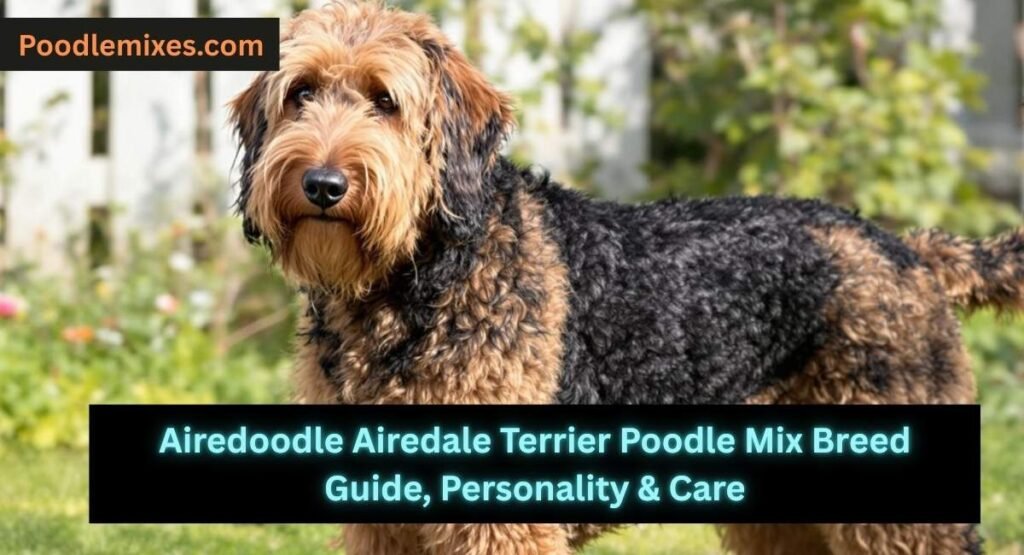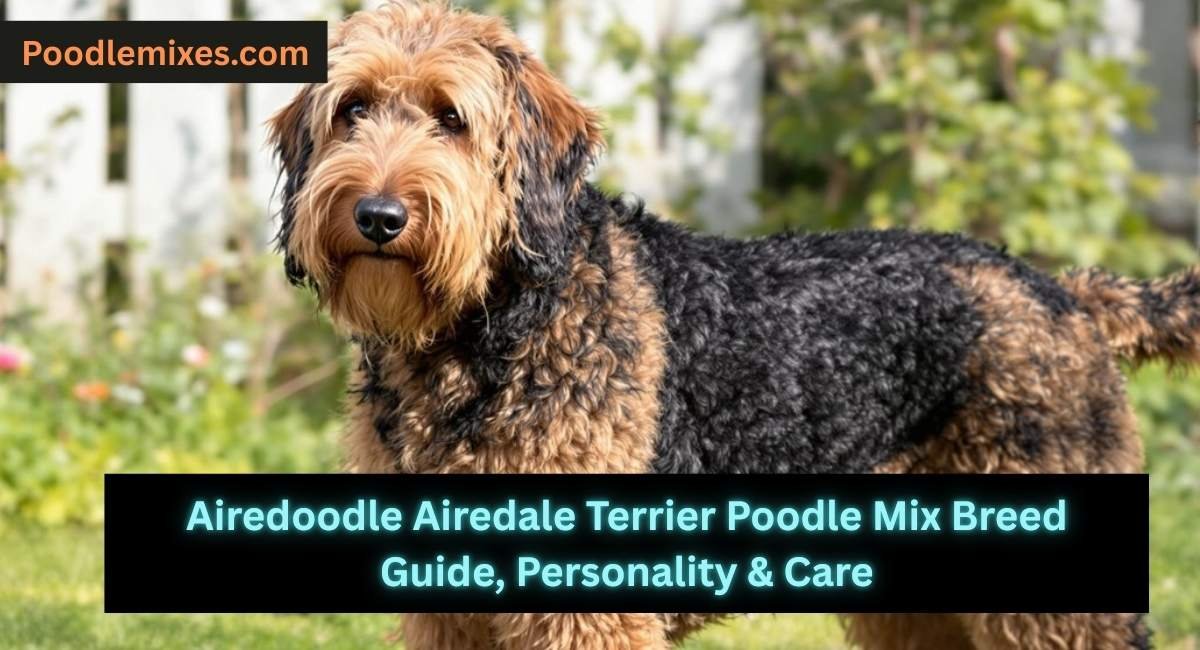The Airedoodle stands as one of the most remarkable hybrid breeds to emerge from the designer dog movement, combining the spirited tenacity of the Airedale Terrier with the brilliant, hypoallergenic qualities of the Poodle. This intelligent crossbreed has captured the hearts of active families seeking a versatile companion capable of everything from adventurous outdoor excursions to cozy family evenings. With their loyal nature, keen intelligence, and striking appearance, Airedoodles represent the best of both parent breeds—offering the protective instincts of the “King of Terriers” alongside the Poodle’s renowned trainability and low-shedding coat.
Originally developed to create a family-friendly dog with the Airedale’s versatility and the Poodle’s hypoallergenic properties, this hybrid has proven exceptionally successful in fulfilling its purpose. Whether serving as an energetic hiking partner, attentive therapy dog, or vigilant family guardian, the Airedoodle adapts seamlessly to various roles. Their medium-to-large size and sturdy build make them robust playmates for children, while their sharp intelligence ensures they thrive when given meaningful jobs and mental stimulation. For the right owner, this breed offers an unparalleled combination of loyalty, humor, and capability.
What is an Airedoodle?
The Airedoodle is a deliberate cross between the Airedale Terrier and Standard Poodle, typically bred in first-generation (F1) or multi-generational crosses. This hybrid emerged during the peak of the designer dog movement in the late 1990s and early 2000s, with breeders aiming to combine the Airedale’s courage and versatility with the Poodle’s intelligence and hypoallergenic coat. Unlike some hybrids created primarily for appearance, the Airedoodle was developed with practical purposes in mind—creating an ideal family companion that could adapt to various lifestyles while minimizing allergic reactions.
The Airedale Terrier contribution brings remarkable history to this mix. Known as the “King of Terriers,” the Airedale originated in the Aire Valley of England where they served as versatile working dogs—hunting otters and rats, guarding property, and even serving as military messengers during World War I. Their confidence, courage, and strong work ethic remain prominent in the Airedoodle temperament. Meanwhile, the Poodle parent—often mistakenly viewed as merely a fancy show dog—brings a history as an accomplished water retriever from Germany, along with one of the canine world’s most impressive intellects and their signature low-shedding coat.

Airedoodle Airedale Terrier Poodle Mix Physical Characteristics
Airedoodles typically stand 18-24 inches at the shoulder and weigh between 40-60 pounds when fully grown, placing them firmly in the medium-to-large dog category. Their build reflects a harmonious blend of both parents: the sturdy, rectangular frame of the Airedale combined with the more refined features of the Poodle. Most Airedoodles inherit the alert, intelligent expression that characterizes both parent breeds, with dark, oval-shaped eyes that seem to constantly assess their surroundings. Their ears typically fold over close to the head, though some may have semi-pricked ears reminiscent of the Airedale.
The coat represents one of the Airedoodle’s most variable features. Most commonly, they exhibit wavy to curly coats that range from low-shedding to virtually hypoallergenic, depending on which parent’s genes dominate. Coat colors vary widely and include black, tan, grizzle, cream, brown, and various combinations thereof. Many Airedoodles display the distinctive tan points of the Airedale parent, particularly on the eyebrows, cheeks, chest, and legs against a darker body. The texture can range from the tight curls of the Poodle to the wiry, broken coat of the Airedale, with many falling somewhere in between with a soft, wavy texture that requires regular maintenance.
Temperament and Personality
The Airedoodle temperament combines the best traits of both parents into an energetic, intelligent, and deeply loyal companion. These dogs typically exhibit the Airedale’s confidence and courage tempered by the Poodle’s sensitivity and people-oriented nature. They form intense bonds with their families and often develop a particular attachment to one person while remaining affectionate with all household members. Their terrier heritage makes them alert and occasionally vocal watchdogs, though they’re generally less territorial than purebred Airedales when properly socialized.
This hybrid’s intelligence shines through in their problem-solving abilities and quick learning—but it also means they require substantial mental stimulation to prevent boredom-related behaviors. Airedoodles thrive on having jobs to do, whether that’s advanced obedience training, agility courses, or simply accompanying their owners on daily activities. Their energy levels reflect their working breed backgrounds, requiring 1-2 hours of vigorous exercise daily. Without adequate physical and mental outlets, they may channel their intelligence into undesirable behaviors like digging, chewing, or learning to open cabinets and doors. Early socialization is crucial to ensure their protective instincts remain balanced and appropriate.
Care and Grooming
Grooming Requirements: Despite being promoted as low-shedding, Airedoodles require significant grooming commitment. Their wavy or curly coats mat easily and need brushing 2-3 times per week with a slicker brush and metal comb. Professional grooming every 6-8 weeks is recommended to maintain coat health and prevent matting. Regular maintenance should include ear cleaning (especially important as floppy ears trap moisture), nail trimming every 3-4 weeks, and dental care through brushing or dental chews.
Exercise Needs: As the offspring of two high-energy working breeds, Airedoodles demand substantial daily exercise—typically 60-90 minutes of vigorous activity. This should include leash walks, off-leash running in secure areas, and mentally stimulating games like fetch, flirt pole sessions, or scent work. They excel at dog sports like agility, nose work, and advanced obedience, which provide both physical and mental challenges. Without adequate exercise, they’re prone to developing destructive behaviors or anxiety.
Training Approach: These intelligent dogs respond best to positive reinforcement methods using food rewards, praise, and play. Their sensitivity means harsh corrections can damage the human-canine bond. Early puppy classes and ongoing socialization throughout adolescence are essential to develop a well-adjusted adult. Consistency is key—Airedoodles will test boundaries and use their intelligence to manipulate situations to their advantage if allowed. Crate training is recommended for house training and preventing destructive behaviors when unsupervised.
Health and Lifespan
Airedoodles typically enjoy a lifespan of 12-15 years, benefiting from the hybrid vigor that often comes with carefully planned crossbreeding. However, they can inherit health concerns common to both parent breeds. Prospective owners should be aware of several conditions:
Hip Dysplasia: Common in medium-to-large breeds, this malformation of the hip joint can lead to arthritis and mobility issues. Responsible breeders screen parent dogs through the Orthopedic Foundation for Animals (OFA) or similar organizations.
Eye Conditions: Both parent breeds can be prone to progressive retinal atrophy, cataracts, and entropion. Regular veterinary eye exams can help detect these issues early.
Skin Allergies: Many Airedoodles inherit the Poodle’s susceptibility to skin allergies, which may require special shampoos, dietary management, or medication.
Gastric Dilatation-Volvulus (Bloat): Deep-chested breeds like the Airedoodle are at higher risk for this life-threatening condition where the stomach twists. Feeding multiple small meals daily and avoiding vigorous exercise around mealtimes can reduce risk.
Preventive care should include regular veterinary check-ups, maintaining a healthy weight to reduce joint stress, and appropriate vaccination and parasite prevention schedules. High-quality nutrition tailored to their life stage and activity level supports overall health and coat condition.
Is an Airedoodle Right for You?
Ideal Home Environment: Airedoodles thrive in active households where they’re included as full family members. They do best with access to securely fenced yards where they can safely burn energy, though they shouldn’t be left alone outside for extended periods. Their size and energy level make them poorly suited for apartment living unless their owners are exceptionally committed to providing sufficient exercise. They’re generally good with children when properly socialized, though their exuberance might overwhelm very young children.
Owner Compatibility: This breed suits experienced dog owners who understand how to manage intelligent, strong-willed dogs. First-time owners may find the Airedoodle’s combination of intelligence, energy, and occasional stubbornness challenging without prior dog experience. They’re ideal for owners who enjoy training and want a versatile partner for various activities. Their protective instincts make them excellent watchdogs, but this can develop into problematic barking or guarding behaviors without proper guidance.
Time Commitment: Prospective owners should honestly assess whether they can meet this breed’s substantial exercise, training, and grooming needs. Airedoodles suffer when left alone for long hours and may develop separation anxiety or destructive behaviors. They’re best matched with owners who work from home, have flexible schedules, or can include them in daily activities. The financial commitment for grooming, high-quality food, and potential health issues should also be considered.
Fun Facts About Airedoodles
- Versatile Workers: Thanks to their Airedale heritage, Airedoodles have been successfully trained for search and rescue work, therapy dog roles, and even as assistance dogs for people with disabilities.
- Water Enthusiasts: Many Airedoodles inherit the Poodle’s love of water and the Airedale’s history as an otter hunter, making them natural swimmers who enjoy water retrieves and swimming sessions.
- Problem-Solvers: Their intelligence means they can learn to open doors, solve puzzle toys quickly, and even manipulate other pets or people to get what they want—keeping life interesting for their owners.
- Late Bloomers: Like many larger breeds, Airedoodles may take 2-3 years to fully mature mentally, often retaining playful, puppy-like behaviors well into adulthood.
- Weather Adaptable: Their double-layer coat provides good insulation in both cold and warm weather, though they should still have access to shade and water in heat and protection from extreme cold.
FAQs (Frequently Asked Questions)
What is the typical size of an Airedoodle?
Airedoodles typically reach 18-24 inches in height and weigh 40-60 pounds, with males generally larger than females. Size can vary depending on whether the Poodle parent was a Standard or smaller variety.
Are Airedoodles hypoallergenic?
While no dog is truly hypoallergenic, Airedoodles are typically low-shedding and produce less dander than many breeds, making them suitable for many people with mild allergies. Individual reactions vary, so spending time with the breed before committing is recommended.
How much exercise does an Airedoodle need?
These energetic dogs require 60-90 minutes of vigorous exercise daily, plus mental stimulation. Without adequate activity, they may develop behavioral issues.
What coat colors do Airedoodles come in?
Common colors include black, brown, grizzle, cream, and various combinations, often with the Airedale’s distinctive tan points. Coat color can be difficult to predict in mixed breeds.
How long do Airedoodles live?
With proper care, Airedoodles typically live 12-15 years, though some may reach older ages with excellent genetics and healthcare.
Are Airedoodles good with children and other pets?
When properly socialized, they’re generally excellent with children and can get along with other pets. Their herding instincts might cause them to nip at running children, and their terrier heritage may give them high prey drive toward small animals.
How often should I groom my Airedoodle?
Brush 2-3 times weekly to prevent mats, with professional grooming every 6-8 weeks. Regular ear cleaning, nail trimming, and dental care are also important.
